

And we just keep goig. The US had about 53,000 cases 24 hours ago, it is now at 68,000. Not enough to get to 100,000 by tomorrow, but still much faster than China ever was, apart from the day when Beijing did a major calculating correction.
The world will reach 500,000 cases today, little more than one day after 400,000 was passed.
Be very careful out there!

• Cases 486,702 (+ 52,134 from yesterday’s 434,568)
• Deaths 22,021 (+ 2,959 from yesterday’s 19,062)

From Worldometer yesterday evening (before their day’s close)
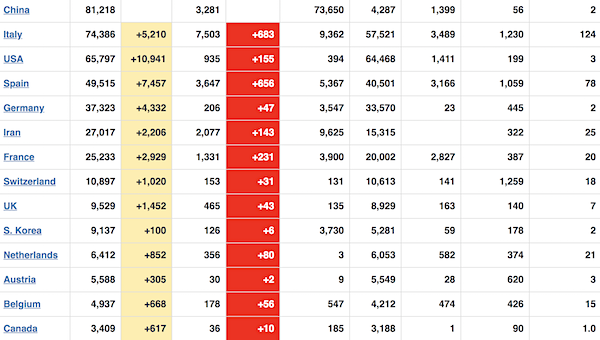
From Worldometer -NOTE: mortality rate for closed cases is at 16% !! Still up 1% per day-
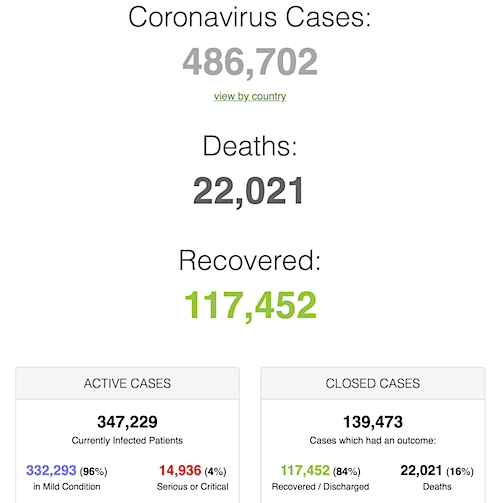
From SCMP:
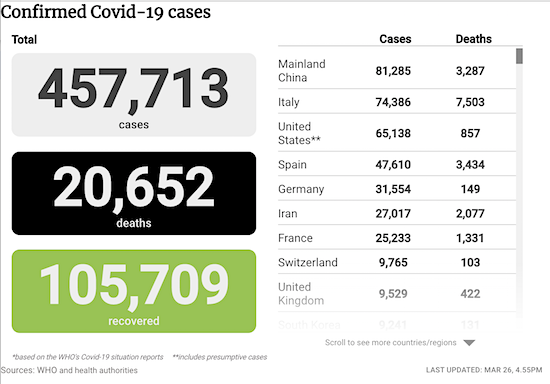
From COVID2019Live.info:
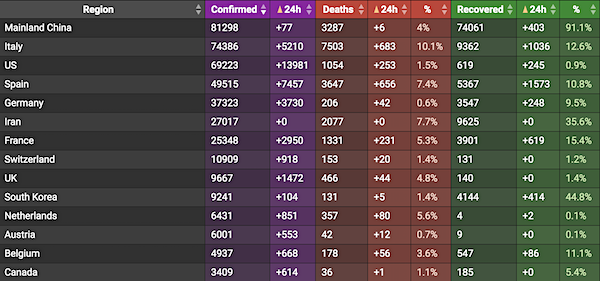
From COVID2019.app:
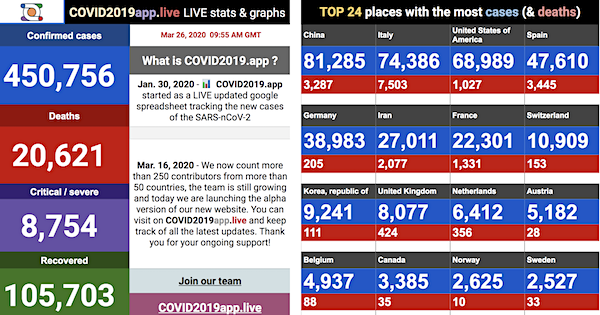

There can be only one conclusion: the US is no longer capable of passing appropriate legislation even in a crisis. Money for the poor? Only if the rich get 1000x as much.
This is an interesting piece. Way beyond the scope of the MSM.
• 1/4 of $2 Trillion Stimulus Bill Devoted to Useless Accounting Gimmick (Tankus)
Earlier this week I wrote about the Trillion dollar platinum coin. Using the coin to fund government spending is often dismissed as an “accounting gimmick”. Yet, accounting gimmicks are already at the center of the Stimulus Bill being debated in congress tonight. 454 billion of the reported 2 Trillion dollars is going to “make loans and loan guarantees to, and other investments in, programs or facilities established by the Board of Governors of the Federal Reserve System”. This is an accounting gimmick. Yet Larry Kudlow (director of the National Economic Council) points to it as one of the most important provisions in the bill.
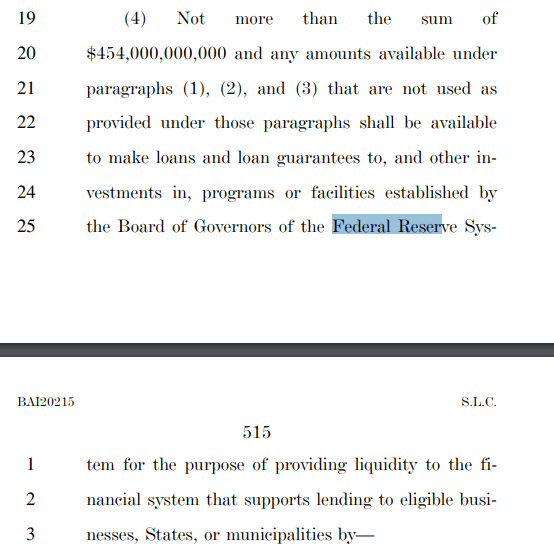
“And finally, I want to mention, the Treasury’s Exchange Stabilization Refund. That will be replenished. It’s important, because that fund opens the door for Federal Reserve firepower to deal a broad-based way throughout the economy for distressed industries, for small businesses, for financial turbulence. You’ve already seen the Fed take action. They intend to take more action. And in order to get this, we have to replenish the Treasury’s Emergency Fund. It’s very, very important; not everybody understands that. That fund, by the way, will be overseen by an oversight board and an inspector general. It will be completely transparent.”
Why does he think it’s important? It’s not exactly clear but it seems that the Trump administration along with the Federal Reserve believe that they do not have the authority to launch the facilities they’ve been launching (partially described in the last post) without special purpose vehicles created by the Treasury. That doesn’t explain why they need money put into a Treasury fund under the discretion of secretary Mnuchin though. Why do they think they need the money? This isn’t clear either but it almost certainly has to do with the Federal Reserve’s net worth. It is a common trope of mainstream economists that it is very important for the central bank to have a positive net worth. If their net worth goes negative, then it should be “recapitalized” by the federal government.
[..] the argument that the net worth of the Federal Reserve matters don’t hold up to very much scrutiny, especially when one is familiar with the legal structure of the Federal Reserve. Yet, this is likely the motivation behind the nearly 500 billion dollars the “stimulus bill” provides the Treasury to support Federal Reserve lending programs. There is no statute, court case or any other binding legal constraint (as far as I can tell at least) that requires the Federal Reserve to have a positive net worth. In fact, it has control over its own accounting rules and as part of its own rules can book its obligation to pay remittances from net income to the Treasury as a “negative liability” (and thus effectively an asset) if its net income falls below zero.
.@BernieSanders ON FIRE on the Senate floor: "And now I find that some of my Republican colleagues are very distressed they're very upset that somebody is making $10-$12 bucks an hour might end up with a paycheck for four months more than they received last week… pic.twitter.com/WIMD7Lzp69
— People for Bernie (@People4Bernie) March 26, 2020

First corona case in New York was on March 1. This hasn’t even begun.
• At Least 13 Patients Die From Coronavirus In One Day At New York Hospital (CNN)
At least 13 patients have died from Covid-19 at Elmhurst Hospital in New York, a statement from a spokesman said, as one of the hardest hit states sees a surge in cases. The deaths of the patients took place over the last 24 hours, but NYC Health and Hospitals/Elmhurst said in a statement that number is consistent with the number of Intensive Care Unit patients being treated there. “Staff are doing everything in our power to save every person who contracts Covid-19,” the statement said. New York has more than 30,000 of the nation’s more than 65,000 coronavirus cases, and 285 of its residents have died from the virus. The state has called for tens of thousands more ventilators, hospital beds and intensive care beds to meet the needs of their hospitals.
Elmhurst is at the center of the crisis, the statement said, and staff is working to overcome the overwhelming numbers. “The frontline staff are going above and beyond in this crisis, and we continue surging supplies and personnel to this critical facility to keep pace with the crisis,” the statement said. “We are literally increasing the effective capacity of the hospital on a daily basis by sending more doctors, nurses, ventilators and PPE to meet demand.” New York has ordered residents to stay at home to curb the spread of the virus and hopefully ease pressures on healthcare systems. And though Gov. Andrew Cuomo pointed to Westchester County — home to the state’s first severe outbreak in New Rochelle — as a marker for the effectiveness of social distancing, cases continue to climb.
Estimates from Sunday showed coronavirus hospitalizations were doubling every 2 days, he said. But Monday’s estimates showed hospitalizations were doubling every 3.4 days, and Tuesday’s estimates showed hospitalizations were doubling every 4.7 days.
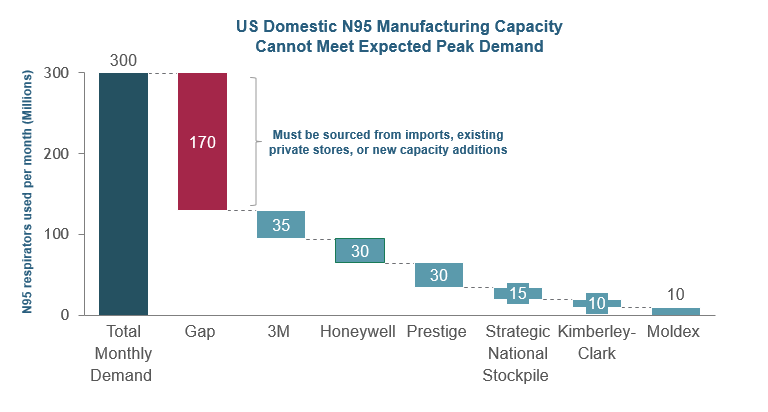

Welcome to Bergamo, Lombardy.
• Worker At NYC Hospital Where Nurses Wear Trash Bags As Protection Dies (NYP)
The shortage of safety gear at one Manhattan hospital is so dire that desperate nurses have resorted to wearing trash bags — and some blame the situation for the coronavirus death of a beloved colleague. A stunning photo shared on social media shows three nurses at Mount Sinai West posing in a hallway while clad in large, black plastic trash bags fashioned into makeshift protective garb. One of them is even holding the open box of 20 Hefty “Strong” 33-gallon garbage bags they used to cloak themselves. “NO MORE GOWNS IN THE WHOLE HOSPITAL,” the caption reads. “NO MORE MASKS AND REUSING THE DISPOSABLE ONES…NURSES FIGURING IT OUT DURING COVID-19 CRISIS.”
The caption includes such hashtags as #heftytotherescue, #riskingourlivestosaveyours and #pleasedonateppe, with the “ppe” referring to “personal protective equipment.” Meanwhile, staffers at the hospital near Columbus Circle on Wednesday tied the lack of basic supplies there to the death of assistant nursing manager Kious Kelly, who tested positive for coronavirus about two weeks ago. Kelly, 48, was admitted to Mount Sinai’s flagship hospital on the Upper East Side on March 17 and died Tuesday night, the workers said. “Kious didn’t deserve this,” one nurse said. “The hospital should be held responsible. The hospital killed him.”
Another nurse described “issues with supplies for about a year now,” during which it got “to the point where we had to hide our own supplies and go to other units looking for stuff because even the supply room would have nothing most of the time.” “But when we started getting COVID patients it became critical,” the nurse said. The nurse sources said they were using the same PPE between infected and non-infected patients and, because there were no more spare gowns in the hospital, they took to wearing trash bags to stop the spread of infection.
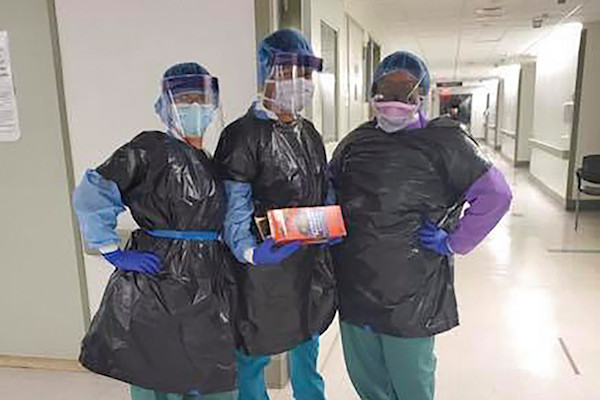
Nurses at Mount Sinai West, where Kelly worked, are being forced to wear trash bags due to the lack of protective gear there.

Hot air only?
• UK Coronavirus Mass Home Testing To Be Made Available ‘Within Days’ (G.)
Thousands of 15-minute home tests for coronavirus will be delivered by Amazon to people self-isolating with symptoms or will go on sale on the high street within days, according to Public Health England (PHE), in a move that could restore many people’s lives to a semblance of pre-lockdown normality. [..] The UK government has bought 3.5m tests, which the health secretary, Matt Hancock, mentioned on Tuesday with no suggestion that they would be available to the public so quickly, and is ordering millions more. Asked if they would be available in days rather than weeks or months, Peacock said: “Yes, absolutely.” If there was a charge for them, she thought it would be minimal, she said.
Widespread availability of a fingerprick test that produces results in 10 to 15 minutes is a game-changer. NHS doctors and nurses with symptoms will know immediately whether they have – or have recovered from – Covid-19, enabling them to get back to work sooner. The UK is not the only country ordering in the antibody tests. “Tests are being ordered across Europe and elsewhere and purchased in south-east Asia. This is widespread practice. We are not alone in doing this,” said Peacock.
Spain's El País reports this morning that Chinese-made #Covid19 rapid testing kits has only 30% sensitivity, as opposed to the 80%-level expected, resulting in failures to detect positive cases in different hospitals. Figures confirmed by govt, it adds. https://t.co/cASYp7AHND
— Stuart Lau (@stuartlauscmp) March 26, 2020

Could=will.
• NHS Could Soon Exceed Capacity – Chief Medical Officer (Ind.)
It will be a “close run thing” whether the NHS capacity will be exceeded over the coming weeks because of the coronavirus outbreak, chief medical officer Chris Whitty has said. At a press conference in 10 Downing Street, Prof Whitty said that there was not currently “enormous” pressure on critical care beds within the health service, despite a total of more than 8,000 patients testing positive for coronavirus across the UK. But he said that he could not guarantee that bed spaces would not run out within the next three weeks. The NHS has more than 4,000 critical care beds in normal times and efforts are under way to accommodate the expected surge in additional coronavirus patients by using private sector facilities and discharging patients able to go home.
The ExCel exhibition centre in east London is being converted into a field hospital which will eventually be able to take 4,000 patients during the outbreak. Prof Whitty said: “The NHS is increasing supply by a combination of pushing out in time things which can be postponed and increasing the critical care and particularly the ventilated bed capacity over the next weeks.” But he added: “This is going to be a close run thing, we all know that. “And anybody who looks around the world can see this is going to be difficult for every health system.”
Prof Whitty said that the lockdown announced by prime minister Boris Johnson on Monday, requiring people to stay at home as much as they can and avoid social contact, should help relieve pressure on bed spaces by reducing the rate of infection, while the NHS works rapidly to increase capacity. “That is the way that we will narrow this down to the smallest possible gap over the next three weeks,” he said.
"Some of the sickest patients have been young… in their 30s and early 40s, previously fit and well"
A&E doctor @DrRosena after a shift at St George's Hospital, London. #Coronavirus | @BBCr4today | https://t.co/Sk08IQVAsR pic.twitter.com/SpMAqv7Wfk
— BBC Radio 4 (@BBCRadio4) March 26, 2020

Time to look at different strains of the virus. Just to be sure. Also, nnext week in the same Guardian: “How Did Britain Get Its Coronavirus Response So Wrong?”.
• How Did Spain Get Its Coronavirus Response So Wrong? (G.)
It is one of the darkest and most dramatic moments in recent Spanish history. In the chilling table of daily dead from the coronavirus pandemic, Spain has taken top position from Italy – with 738 dying over 24 hours. Spain is now the hotspot of the global pandemic, a ghoulish title that has been passed from country to country over four months – starting in Wuhan, China, and travelling via Iran and Italy. As it moves west, we do not know who will be next. What went wrong? Spain had seen what happened in China and Iran. It also has Italy nearby, just 400 miles across the Mediterranean and an example of how the virus can spread rapidly and viciously inside Europe.
Yet Spaniards cannot blame that proximity. There are no land borders with Italy, while France, Switzerland, Austria and Slovenia – all countries that are doing much better – do have them. This may, in fact, be one of the reasons for the country’s late response. Spain thought it was far enough away. “Spain will only have a handful of cases,” said Dr Fernando Simón, the head of medical emergencies in Madrid, on 9 February. Six weeks later he gives out daily figures of hundreds of deaths. The number of dead per capita is already three times that of Iran, and 40 times higher than China. On 19 February, 2,500 Valencia soccer fans mixed with 40,000 Atalanta supporters for a Champions League game in Bergamo which Giorgio Gori, mayor of the Italian city, has described as “the bomb” which exploded the virus in Lombardy.
In Spain, Valencia players, fans and sports journalists were amongst the first to fall ill. The main reason for the quick spread through Spain may be completely mundane. It has been an unusually mild, sunny Spring. In late February and early March, with temperatures above 20C (68F), Madrid’s pavement cafes and bars were heaving with happy folk, doing what Madrileños like best – being sociable. That means hugging, kissing and animated chatter just a few inches from someone else’s face. On 8 March, just a week before the country was closed down, sports events, political party conferences and massive demonstrations to mark International Women’s Day all took place. Three days later, about 3,000 Atlético de Madrid fans flew together for another Champions League match in Liverpool.
[.] The virus has laid bare, too, deep faults in the Spanish care system. Private old people’s homes must turn a profit while charging people prices they can afford – which may be a basic pension of just over 9,000 euros. As a result, these were understaffed, unprepared and quickly overwhelmed, with death rates of up to 20%. The army was sent in, and found some people lying dead in their beds. Spain has a magnificent primary care system, but its hospitals have been hit by a decade of austerity since the financial crisis. It has only a third of the hospital beds per capita that are provided by Austria or Germany. Yet that is still more than the UK, New Zealand or the US.
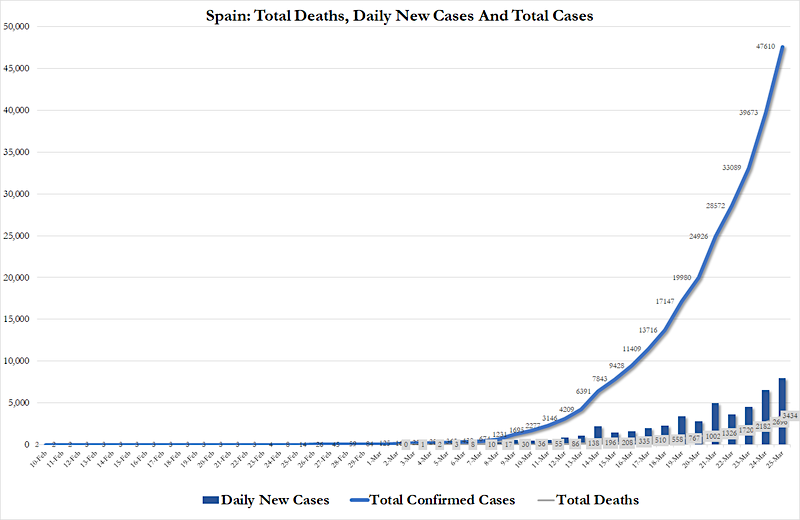

How much of the recent bad rap is coming from Big Pharma, which can’t make a dime on the stuff?
• Bahrain, Belgium Report Hydroxychloroquine Treatment Is Working For Patients (JTN)
Bahrain and Belgium report their hospitals are successfully treating coronavirus patients with the anti-malaria drug hydroxychloroquine touted by President Trump as a possible breakthrough in the pandemic. The Kingdom of Bahrain’s Supreme Council of Health chairman said his country was among the first to use the drug and that its impact has been “profound,” according to the Bahrain News Agency. Dr. Shaikh Mohamed, who leads the National Taskforce for Combating COVID-19, was also quoted by the news agency as saying hydroxychloroquine was administered according to the same regimens as those used in China and South Korea. The first COVID-19 case in Bahrain was reported on Feb. 21, and hydroxychloroquine was first administered to patients showing virus symptoms on Feb. 26.
Bahrain has 419 deaths as a result of the virus, behind Croatia with 442 deaths worldwide, according to the Johns Hopkins Coronavirus Research Center. Hydroxychloroquine is used to prevent and treat malaria and is administered to patients with rheumatoid arthritis or lupus. Meanwhile in Europe, another U.S. ally, Brussels, is reporting similar early success with the same drug and is taking steps to ensure its availability for the sickest coronavirus patients. “Using the limited stocks of these medicines for unnecessary or unjustified preventive treatments jeopardizes the availability of these medicines for patients who need them: chronic patients and hospital patients seriously affected by Covid-19,” Belgium’s Federal Agency for Medicines and Health Products said this week.

What a bit of bad publicity won’t do…
• Gilead Sciences Backs Off Monopoly Claim For Promising Coronavirus Drug (IC)
Gilead Sciences on Wednesday announced that it has submitted a request to the Food and Drug Administration to rescind the exclusive marketing rights it had secured for remdesivir, an antiviral drug that shows promise in treating Covid-19, the disease caused by the new coronavirus. As The Intercept reported on Monday, the FDA had awarded Gilead seven years of exclusive marketing rights to the drug through the Orphan Drug Act, even though the statute was designed to induce pharmaceutical companies to make treatments for rare diseases that affect fewer than 200,000 people in the United States. Although the new coronavirus will almost certainly infect that many people, Gilead had exploited a loophole that grants orphan drug status if a company files for it before the official number of cases hits 200,000.
As of Wednesday afternoon, there were more than 438,000 confirmed cases worldwide, with more than 59,000 in the United States. After a public outcry, Gilead issued a press release stating: “Gilead has submitted a request to the U.S. Food and Drug Administration to rescind the orphan drug designation it was granted for the investigational antiviral remdesivir for the treatment of Covid-19 and is waiving all benefits that accompany the designation. Gilead is confident that it can maintain an expedited timeline in seeking regulatory review of remdesivir, without the orphan drug designation. Recent engagement with regulatory agencies has demonstrated that submissions and review relating to remdesivir for the treatment of Covid-19 are being expedited.”

It’s all about money, and only about money. Even at this point.
• How Big Science Skipped Clinical Trials After Past Coronavirus Outbreaks (JTN)
Equally alarming was the lack of followup after early drug studies found some promising treatments that worked anecdotally during the SARS outbreak in 2003, two smaller coronavirus outbreaks in 2004-05, and MERS in 2012. The anti-malarial drug known as chloroquine was one of a handful flagged as a potential treatment. One such study in 2005 found “chloroquine has strong antiviral effects on SARS-Cove infection of primate cells. These inhibitory effects are observed when the cells are treated with the drug either before or after exposure to the virus, suggesting both prophylactic and therapeutic advantage.” The 2005 study concluded: “Chloroquine is effective in preventing the spread of SARS CoV in cell culture. Favorable inhibition of virus spread was observed when the cells were either treated with chloroquine prior to or after SARS CoV infection.”
Similarly, in 2009 the University of Leuven in Belgium published “Antiviral Activity of Chloroquine against Human Coronavirus OC43 Infection in Newborn Mice,” which warned of a failure to follow up on possible treatments. “Although coronaviruses have been recognized as human pathogens for about 50 years, no effective treatment strategy has been approved,” the authors wrote. “This shortcoming became evident during the SARS-CoV outbreak and was the start of numerous studies. Nevertheless, 5 years after the outbreak, we are still lacking an effective, commercially available drug. Chloroquine is a clinically approved drug effective in malaria, and it is known to elicit antiviral effects against several viruses.” Such promise and warnings never translated into action, and as a result more detailed clinical trials that could validate or rule out treatments were never carried out.
To understand why, former Health and Human Service Secretary Tom Price said, one must understand the economics and psychology of private and government medical research. One-time treatments that have no long-term commercial market don’t excite pharmaceutical companies in the business of making profits. And federal scientists always like jumping to the next big viral fire instead of finishing work on an earlier outbreak that fizzled like SARS, he explained. “One would think that those studies would have been completed before now,” said Price, a doctor himself and a former congressman. “However, the extent of SARS was relatively small and short-lived. Once the threat passed, there was no economic incentive for pharmaceutical companies to complete human trials, and governmental attention, research and inertia moved in a different, seemingly more urgent, direction.”

That’s literally what I said last week: “Comparing Covid-19 and flu numbers is a classic case of apples to oranges, according to public health experts and epidemiologists.”
Still, if this is Trump’s deadly mistake, he shares that feat with about a billion other people.
• Trump’s Deadly Mistake In Comparing Coronavirus To Flu (IC)
The President of the United States compared the coronavirus to the flu this week, and the new virus that has already stricken more than 55,000 people and killed more than 800 across the country came out looking relatively innocuous. “We have a lot of people dying from the flu, as you know,” Donald Trump told reporters at the White House, as his attorney general, William Barr, stood far less than 6 feet behind him. “It looks like it could be over 50,000,” he said about the current flu season, later clarifying that he was referring to deaths from the flu, “not cases, 50,000 deaths, which is a lot.” But the number Trump cited does not reflect people dying from verified cases of the flu. According to data from the CDC, 7,428 deaths from the flu were confirmed by a lab test for that virus in 2019.
If you add in the 3,771 test-confirmed deaths already tallied in 2020, the total number of deaths that can be definitively tied to the flu is 11,199. The much higher number Trump used comes from the possible range of deaths attributable to flu this season — 23,00 to 59,000 — a number that the CDC estimates in part by including people who die from pneumonia even if they weren’t tested for the flu virus. Trump contrasted the high flu numbers — along with automobile accidents, which he said were “far greater than any numbers we’re talking about” — to the number of Covid-19 cases in part to emphasize his administration’s success in responding to the deadly virus. “I think we’re doing a very good job of it,” he said, going on to describe the number of cases in the U.S. as “pretty amazing.”

Maybe some cities should sleep a bit more?
• Cairo, The City That Never Sleeps, Shuts For Coronavirus Night-Time Curfew (R.)
Egypt and its capital Cairo, a mega-city home to some 20 million people, shut down on Wednesday evening as authorities launched a night-time curfew to tackle the spread of the coronavirus. In a city that never sleeps where restaurants and cafes are usually open until the wee hours, shop owners were closing shutters and commuters rushing home before the start of the 7 p.m. curfew that runs until 6 a.m. Policemen were posted on key roads to stop any violators. Many streets were already almost deserted by 6:30 p.m. “This is a disease, not a joke. People must stay at home, and should not leave their houses after curfew hours,” Mohamed El-Gabaly, a Cairo resident, told Reuters, as he stood in a major street with little traffic just before the curfew.
Egypt has stepped up measures aimed at preventing the spread of the coronavirus – closing airports and gyms, as well as suspending classes at schools and universities until mid-April. Restaurants are restricted to just delivering food. Shops other than supermarkets and pharmacies will be required to close at 5 p.m. on weekdays, two hours earlier than the previous curfew, as well as on weekends. Egypt, a country of 100 million, has reported 456 confirmed cases of the coronavirus and 21 deaths.

Andrew the Jailer.
• Crisis Daddy Cuomo Uses Coronavirus For New York Bail Reform Rollback (IC)
As the coronavirus pandemic grips the United States, prosecutors, sheriffs, and public officials have raced to reduce the populations held in local jails, where it is next to impossible to protect elderly and otherwise vulnerable incarcerated people. In New York, however, Gov. Andrew Cuomo is bucking this trend, pushing for a new law that would roll back newborn bail reforms that went into effect in January and instead expand judges’ power to put defendants in jail. Cuomo has backed this agenda for years, but his evident insistence on including it in the state’s budget negotiations amid a public health crisis is nonetheless remarkable.
“Every other elected official across the country is thinking about how they can reduce their jail and prison population,” Rena Karefa-Johnson, the New York state director for criminal justice reform for the advocacy group FWD.us, said in an interview. “But in New York, we have elected officials still trying to change legislation that would put thousands more people back in jail and slowing up an emergency budget process to do it. It’s wildly out of step with what’s happening across the country, and it’s wildly at odds with this narrative of New York taking Covid-19 seriously and keeping people safe. It’s bonkers.” The governor’s move comes as his power is ascendant. Cuomo has always wanted to be a crisis governor, engaging in well-documented disaster heroics whenever roadways get slippery.
But that instinct, risible in peacetime, is playing differently in the pandemic. People in New York and around the country are terrified, and the erratic federal response under President Donald Trump has been far from reassuring. Cuomo’s sober, authoritative daily briefings have filled the vacuum. In the last weeks, Cuomo has become America’s Governor, its crisis daddy. In recent days the hashtag #PresidentCuomo has been trending on Twitter. With his popularity soaring, and his constituents preoccupied with looming mass fatalities as the coronavirus threatens to overwhelm the state’s health care capabilities, Cuomo is well positioned to drive through his preferred agenda with hardly anyone noticing.

This, too, has only just begun.
• California Sees 1 Million Unemployment Claims In Less Than Two Weeks (CNBC)
California Gov. Gavin Newsom said Wednesday that the state has seen 1 million unemployment claims in less than two weeks as the coronavirus pandemic has led to businesses being shut down across the state. “We just passed the 1 million mark, in terms of the number of claims, just since March 13,” Newsom said. Newsom’s announcement comes one day before a key national data release on new jobless claims for the United States, which some have projected to be in the multimillions. The initial claims data has never before surpassed 1 million, and it was 285,000 last week.
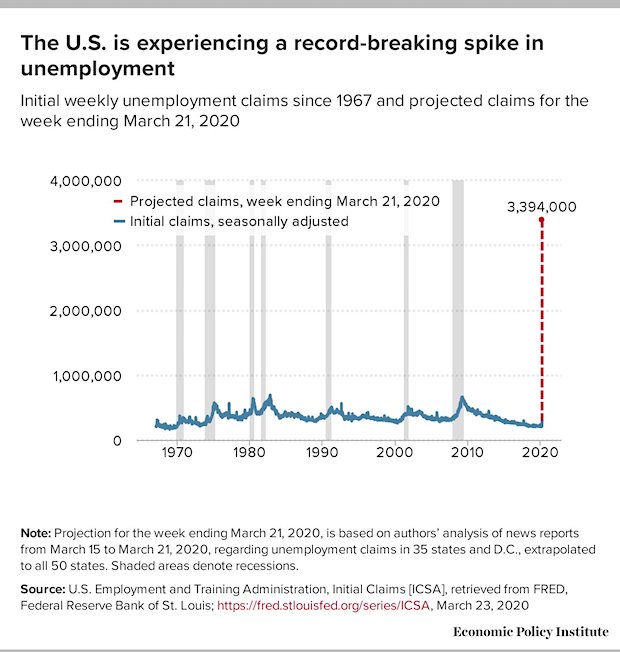
The San Francisco area was the first region in the country to install a “shelter-in-place” order, on March 16. Newsom signed a “stay-at-home” order for the whole state three days later. The governor praised the proposed Senate relief bill to help fight the coronavirus pandemic. California provides up to $450 per week for unemployment insurance, Newsom said, and the proposed Senate bill would add $600 per week for up to four months. “This bill will be very helpful, and it’s very timely,” Newsom said. California and its cities will get $10 billion from a block grant portion of the proposed relief bill in the Senate, not including the benefits to workers and individuals, Newsom said.
The chart below shows the United States GDP growth over the last 90 years including a variety of forecasts for Q2 2020.
Most of them predict the worst economic quarter in American history. Even worse than during the Great Depression (1930s).
Data 1930-1946 shows annual growth pic.twitter.com/Iz3TKLtHL7— Sebastian Sienkiewicz (@Amdalleq) March 23, 2020

But don’t be surprised if they invade Iran or Venezuela tomorrow morning. And they call this message a great tactical move.
• Pentagon Orders A Stop-Movement For All Overseas Troops (JTN)
The Pentagon on Wednesday issued a stop-movement order for all overseas military personnel and civilians for the next 60 days. The measure, designed to prevent the spread of the coronavirus pandemic, follows a previous order that puts a hold on troop movements within the United States. The newly issued order is meant to protect U.S. personnel, and preserve operational readiness, the Pentagon said. The order will interrupt scheduled exercises, deployments, and other overseas activities. “Approximately 90,000 Service Members slated to deploy or deploy over the next 60 days will likely be impacted by this stop movement order,” the statement read. The order includes exceptions for some personnel, including those who currently are traveling. The order is not expected to interfere with the drawdown of U.S. forces from Afghanistan, according to the statement.

When the judge is a murderer.
• Judge Refuses To Release Julian Assange Over Coronavirus Risk (Ind.)
A judge has refused to release Julian Assange from prison over the coronavirus outbreak. The Wikileaks founder’s lawyers had applied for him to be freed on bail because he was “vulnerable” to the virus inside HMP Belmarsh. He is being held there while awaiting potential extradition to the US on charges relating to the 2010 Wikileaks publications over the Iraq and Afghanistan wars. Mr Assange at Westminster Magistrates’ Court by video-link on Wednesday and was represented by Edward Fitzgerald QC, who wore a surgical mask. The court heard that despite coronavirus being confirmed in other jails, there were not yet an known cases in HMP Belmarsh. But Mr Fitzgerald said that 100 prison officers were off work, adding: “We say there’s a very real problem, a very real risk and the risk could be fatal.”
District judge Vanessa Baraitser refused the bail application, telling the court: “As matters stand today, this global pandemic does not of itself yet provide grounds for Mr Assange’s release.” Supporters of Mr Assange said he had a previously reported lung complaint and was in an “already weakened medical condition”. Kristinn Hrafnsson, editor in chief of Wikileaks, said: “To expose another human being to serious illness, and to the threat of losing their life, is grotesque and quite unnecessary. This is not justice, it is a barbaric decision.” American and British authorities class Mr Assange as a flight risk because he skipped bail over Swedish sexual assault allegations to flee to London’s Ecuadorian embassy in 2012.

At least 2 prisoners have already died from the virus in UK jails. 350 have been released.
• US High Court Rejects Call To Free 736 Detainees At Risk From Coronavirus
The high court has rejected calls to free hundreds of immigration detainees who, lawyers and human rights activists say, are at risk from Covid-19 while behind bars. The ruling, following a hearing over Skype on Wednesday, was handed down in response to an urgent legal challenge from Detention Action. The legal action asked for the release of hundreds of detainees who are particularly vulnerable to serious illness or death if they contract the virus because of particular health conditions, and also for the release of those from about 50 countries to which the Home Office is currently unable to remove people because of the pandemic. The two judges – Dame Victoria Sharp, president of the Queen’s Bench division, and Mr Justice Swift – came down strongly on the side of the Home Office and highlighted the range of measures already being implemented by the home secretary, Priti Patel.
These included the release of more than 300 detainees last week, ongoing assessments of the vulnerability of individual detainees to the virusand a range of “sensible” and “practical” steps the Home Office is taking to make detention centres safer, such as single occupancy rooms and the provision of face masks for detainees who wish to wear them. “It seems likely that the arrangements already in place by the secretary of state will be sufficient to address the risks arising in the majority of cases,” the judges said, adding that “the present circumstances are exceptional”. The court hearing on Wednesday heard that 736 people are still being detained in the UK, while 350 have been released in recent days. It was also confirmed that detainees in three detention centres have displayed symptoms of Covid-19.

#MeToo, but not you.
• Time’s Up Said It Could Not Fund #MeToo Allegation Against Joe Biden (IC)
Last April, Tara Reade watched as a familiar conversation around her former boss, Joe Biden, and his relationship with personal space unfolded on the national stage. Nevada politician Lucy Flores alleged that Biden had inappropriately sniffed her hair and kissed the back of her head as she waited to go on stage at a rally in 2014. Biden, in a statement in response, said that “not once” in his career did he believe that he had acted inappropriately. But Flores’s allegation sounded accurate to Reade, she said, because Reade had experienced something very similar as a staffer in Biden’s Senate office years earlier.
After she saw an episode of the ABC show “The View,” in which most of the panelists stood up for Biden and attacked Flores as politically motivated, Reade decided that she had no choice but to come forward and support Flores. She gave an interview to a local reporter, describing several instances in which Biden had behaved similarly toward her, inappropriately touching her during her early-’90s tenure in his Senate office. In that first interview, she decided to tell a piece of the story, she said, that matched what had happened to Flores — plus, she had filed a contemporaneous complaint, and there were witnesses, so she considered the allegation bulletproof. The short article brought a wave of attention on her, along with accusations that she was doing the bidding of Russian President Vladimir Putin. So Reade went quiet.
[..] As the campaign went on, Reade [..] began to reconsider staying silent. She thought about the world she wanted her daughter to live in and decided that she wanted to continue telling her story and push back against what she saw as online defamation. To get legal help, and manage what she knew from her first go-around would be serious backlash, she reached out to the organization Time’s Up, established in the wake of the #MeToo movement to help survivors tell their stories. The Time’s Up Legal Defense Fund was the recipient of an outpouring of donations over the past two-plus years, and is set up as a 501(c)3 nonprofit housed within the National Women’s Law Center. It was launched in December 2017 and was the most successful GoFundMe in the site’s history, raising more than $24 million.
[..] By February, she learned from a new conversation with Time’s Up, which also involved Director Sharyn Tejani, that no assistance could be provided because the person she was accusing, Biden, was a candidate for federal office, and assisting a case against him could jeopardize the organization’s nonprofit status.


Readership is up a lot, but ad revenue only keeps dropping. I’ve said it before, it must be possible to run a joint like the Automatic Earth on people’s kind donations. These are no longer the times when ads pay for all you read, your donations have become an integral part of it. It has become a two-way street; and isn’t that liberating, when you think about it?
You heard it here first, like so many other things. And no, though it would be far more lucrative financially, the Automatic Earth will not adopt any paywalls, not here and not on Patreon. But you can still support us there, as well as right here. It’s easy. Thanks everyone for your donations the past few days. Very much obliged.

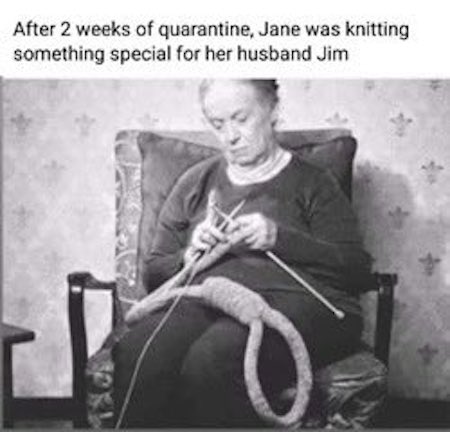


Support us in virustime. Help the Automatic Earth survive. It’s good for you.


Home › Forums › Debt Rattle March 26 2020